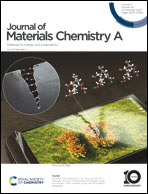Elucidating the mechanism underlying the augmented capacity of MoO2 as an anode material in Li-ion batteries†
Abstract
Transition-metal oxide anode materials have been observed to possess an intriguing surplus of capacity beyond the expected values based on conversion reaction. However, the mechanisms behind this phenomenon have remained contentious and elusive. This study focuses on synthesized nanosized molybdenum dioxide and its electrochemical performance as an anode material for Li-ion batteries. Our findings reveal a substantial increase in capacity upon cycling, achieving approximately 1688 mA h g−1, nearly double the theoretical capacity, after 700 cycles at a 1C rate. To elucidate the mechanisms underlying this augmented capacity, a comprehensive analysis employing in situ and ex situ X-ray diffraction, X-ray absorption spectroscopy, scanning electron microscopy, and transmission electron microscopy was conducted at various stages of the Li-ion cell cycling. Our results indicate that no conversion reaction occurs during the initial discharge phase, with Li2O and Mo remaining undetected. Instead, Li0.98MoO2 is generated upon lithiation. Further materials characterization employing electron energy loss spectroscopy and energy-dispersive X-ray spectroscopy on the cycled electrode suggests the potential formation of a metallic Li-rich layer at the interface of the Li-ion intercalated phase subsequent to the formation of Li0.98MoO2, contributing to the surplus Li storage. Moreover, electrochemical impedance spectroscopy coupled with ex situ SEM and TEM analyses reveals that alterations in particle size and morphology, along with changes in the solid electrolyte interphase (SEI) resistance, are instrumental in the capacity variation observed upon cycling.



 Please wait while we load your content...
Please wait while we load your content...
